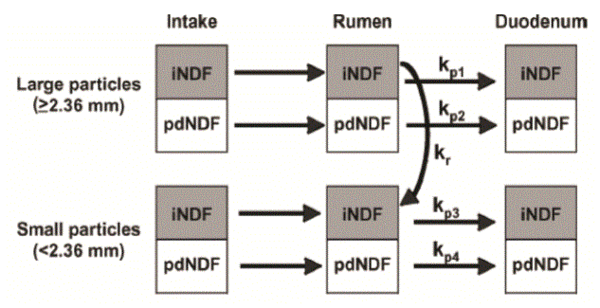Effect of NDF digestibility on Diet Formulation and Animal Performance
Published: August 4, 2017
By: Charles J. Sniffen / Fencrest, LLC PO Box 153, 949 US Rte 3, Holderness, NH 03245, USA.
Introduction
The work of Dr. Mike Allen, Michigan State in the late 80’s, measuring NDF digestibility of different corn silage hybrids, initially resulted in much controversy. There was much resistance to the concept that differences in fiber digestibility in corn silage could have an impact on animal performance. He proceeded to do studies with BMR hybrids as well as with conventional hybrids both in lactating cow studies as well as a demonstration of a wide range of digestibility’s among hybrids and over years.
The argument was made that there was more variation over years than there was among hybrids. However, he demonstrated that within any year there were hybrids that always were on the top in digestibility and those that were always on the bottom. He then extended this work to forages other than corn silage, essentially demonstrating the same concept.
Today, in the USA, NDF digestibility has become a routine measurement both as an in vitro measurement as well as with the use of NIR prediction.
NDF Digestibility Measurements
The method for the measurement of NDF digestibility has not been without controversy. NRC suggested that the appropriate measurement was to do a 48 hour Tilley Terry in vitro. Dr. Allen suggested that a 30 hour in vitro was much more sensitive in terms of animal response, which was based more on a consideration of rumen retention time and rumen turnover kinetics of a lactating cow. The 48 hour measurement is more suitable to providing a prediction of TDN at maintenance which then could be converted to a NEL estimate. The 30 hour measurement came closer to being sensitive to intake and the prediction of performance of a cow. The 30 hour measurement was quickly adopted by forage labs in the East and then used as a means to adjust rations. The Midwest continued to use the 48 hour measurement as a method of ranking forages, however, currently Midwestern forage labs are now doing 30 hours measurements as well.
There has been the introduction of the use of the Ankom system to measure fiber digestion. This is attractive because many samples can be analyzed at one time relatively quickly at very reasonable costs. There appear to be some issues with this approach. There appears to be more variation among duplicates which can be due, in part, by bag pore size with sample loss and less uniformity within the fermenter jar system. The Tilley Terry system appears to give more uniform results.
The challenge with the in vitro system is rumen fluid preparation, buffer type, and fiber and lignin analyses. The amount of lag before fermentation actually occurs is actually quite variable among labs. Lag needs to be determined. If lag exceeds 3 hours, methodology needs to really be examined closely. With long lag times, measurements of NDFd become problematical at 24 and 30 hours, even if we correct for the lag. This is an in vitro procedure and requires good technique.
The use of NDF Digestibility
The major problem with the NDF digestibility measurement was how to incorporate the information into a ration program. The 48-hour measurement could be used in the NRC 2001 estimate for net energy, using the Weiss equations, however not many people were using NRC 2001. Van Amburgh, Van Soest and colleagues developed a spreadsheet to estimate the rate of digestion of the available pool. Below is an example of a high protein ryegrass with a 24 hour NDF digestibility.

There is an estimate of the unavailable pool of 2.4*lignin. This has been questioned by several researchers and recently, the Cornell group, reevaluating this has found that the unavailable pool might be different among forage types and maturities. A rate of digestion (Kd) for one pool is predicted, with a correction for lag, that is a weighted value which is now used in the CNCPS based models, assuming one pool and has worked well in the field. Of interest is the prediction of the two pools and their associated Kd’s. The concept of two pools does make biological sense. In current work with different hybrids in corn, it has been interesting to note that there is significant genetic diversity relative to these pools. The question yet to be answered is, will having two pools enhance our ability to predict performance in cattle?
Dr. Allen in a series of papers presents an integrative model which uses two pools to describe fiber dynamics in a cow. Below is the most recent model describing these dynamics. The major factor is particle size with particle size reduction rates (Kr). The iNDF is the indigestible pool and the pdNDF is the potentially digestible pool. There are 4 passage rates, describing that the particles from the particle pools larger than 2.36mm moves at different rates than the particle pools less than 2.36mm, with different Kp’s for the pdNDF in the two pools This model does not provide the disappearance rate of the pdNDF from the two particle pools however this is detailed in other models. If one were to expand on the model below to incorporate a division of the pdNDF pool into fast and slow pools, this might provide some enhancement to this model. We have forages like BMR corn and BMR sorghum as well as new varieties of grasses with large fast pools that allow us to suggest this approach.
We have found that the prediction and use of the NDF Kd’s has significantly improved our ability to predict animal performance. Our goal, of course, is to better predict the upper and lower limits of forage that can be included in a ration. The lower limit to keep the cow healthy and the upper limit to be able to have high productivity at lower cost. The integrative model above provides direction on how this might occur.

The Future
Forages are absolutely needed at a minimum level to provide for normal rumen function. The particle size distribution of the forage is critical to the proper formulation. We routinely make the recommendation to increase the % forage in the ration when BMR corn silage is fed because the forage has a large fast rate digestibility pool as well as a very fast rate (Kr) of particle size reduction. Miner Institute has been measuring the rate of particle size reduction with a ball mill and has found that this rate is well correlated with the NDF digestibility.
We need to improve the methodology for measuring NDFd. The data support that there are two pools of fiber. Work at Miner Institute is examining the impact of the ester and ether bonds to the core lignin on fiber digestibility and its potential link to fragility of the particles. This will help us in refining our prediction of fiber digestion, gut fill, particle size reduction rates, and animal productivity.
There has been extensive work done with enzymes, yeasts and other rumen additives as a means to improve fiber digestion. The enzyme approach has seen variable results. The use of yeast may be indirect through pH control but has shown consistent positive results with certain live yeasts.
With our continued work with improving plant genetics for fiber digestion, understanding of soil and environmental management practices that influence fiber digestion, we will improve animal productivity and efficiency. With the understanding of the variation in fiber digestion, we will be able to better use different products to reduce the variation in fiber digestion.
Presented at the NDF 2010 Symposium.
Literature
Cotanch, K. W. and R. J. Grant. 2009. Measuring physically effectively fiber on-farm to predict cow response. Proc Cornell Nutr. Conf.
National Research Council, 2001. nutrient requirements of dairy cattle, 7th Revised Ed. National Academy Press; Washington, D.C.
Oba, M and M.S. Allen. 1999. Evaluation of the importance of the digestibility of neutral detergent fiber from forage: effects on dry matter intake and milk yield of dairy cows. J. Dairy Sci. 82:589-596.
Tilley, J.M.A. and Terry, R.A. 1963. A two stage technique for the in vitro digestion of forage crops. Journal of the British Grassland Society, 18: 104-111.
Van Amburgh, M.E., P.J. Van Soest, J.B. Robertson, and W.F. Knaus. 2004. Corn silage neutral detergent fiber: Refining a mathematical approach for in vitro rates of digestion. Cornell Nutrition Conference Proceedings. Pp. 99-108.
Voelker Linton, J. A. and M. S. Allen. 2007. Nutrient demand affects ruminal digestion responses to a change in dietary forage concentration. J. Dairy Sci. 90:4770–4779.
Related topics:
Authors:
Influencers who recommended :
Dr. N.r.sarkerRecommend
Comment
Share
Perry Brook Dairy Farm
12 de agosto de 2018
Charlie
If we allow Soy Hulls in our TMR should we be able to put a ration together with more dNDF
and possibly move our B F up. Is there any source of Rumen Protected Histidine commercially?
Recommend
Reply

Would you like to discuss another topic? Create a new post to engage with experts in the community.






